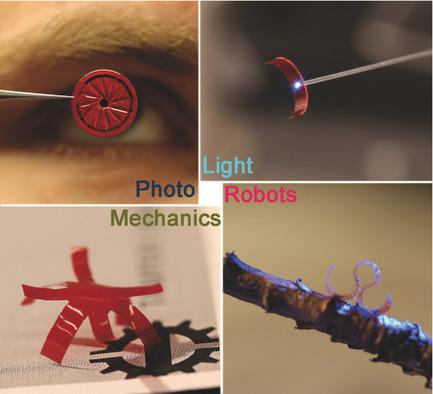当前位置:
X-MOL 学术
›
Adv. Mater.
›
论文详情
Our official English website, www.x-mol.net, welcomes your feedback! (Note: you will need to create a separate account there.)
Light Robots: Bridging the Gap between Microrobotics and Photomechanics in Soft Materials
Advanced Materials ( IF 29.4 ) Pub Date : 2017-10-25 , DOI: 10.1002/adma.201703554 Hao Zeng 1 , Piotr Wasylczyk 2 , Diederik S. Wiersma 3 , Arri Priimagi 1
Advanced Materials ( IF 29.4 ) Pub Date : 2017-10-25 , DOI: 10.1002/adma.201703554 Hao Zeng 1 , Piotr Wasylczyk 2 , Diederik S. Wiersma 3 , Arri Priimagi 1
Affiliation

|
For decades, roboticists have focused their efforts on rigid systems that enable programmable, automated action, and sophisticated control with maximal movement precision and speed. Meanwhile, material scientists have sought compounds and fabrication strategies to devise polymeric actuators that are small, soft, adaptive, and stimuli‐responsive. Merging these two fields has given birth to a new class of devices—soft microrobots that, by combining concepts from microrobotics and stimuli‐responsive materials research, provide several advantages in a miniature form: external, remotely controllable power supply, adaptive motion, and human‐friendly interaction, with device design and action often inspired by biological systems. Herein, recent progress in soft microrobotics is highlighted based on light‐responsive liquid‐crystal elastomers and polymer networks, focusing on photomobile devices such as walkers, swimmers, and mechanical oscillators, which may ultimately lead to flying microrobots. Finally, self‐regulated actuation is proposed as a new pathway toward fully autonomous, intelligent light robots of the future.
中文翻译:

轻型机器人:弥合软材料中的微型机器人与光机械之间的差距
几十年来,机器人专家一直致力于将刚性系统用于可编程,自动动作以及以最大运动精度和速度进行复杂控制的系统。同时,材料科学家一直在寻求化合物和制造策略,以设计出体积小,柔软,自适应且具有刺激响应能力的聚合物致动器。这两个领域的融合催生了一种新型的设备-软微型机器人,通过结合微型机器人和刺激响应材料研究的概念,以微型形式提供了以下优势:外部,远程可控制的电源,自适应运动和人为的友好的互动,设备设计和动作通常受生物系统启发。在此处,基于光响应性液晶弹性体和聚合物网络,软微机器人的最新进展得到了强调,重点是诸如步行者,游泳者和机械振荡器之类的光移动设备,这些设备最终可能会导致微型机器人的飞行。最后,提出了自我调节的驱动装置,作为通往未来全自动,智能照明机器人的新途径。
更新日期:2017-10-25
中文翻译:

轻型机器人:弥合软材料中的微型机器人与光机械之间的差距
几十年来,机器人专家一直致力于将刚性系统用于可编程,自动动作以及以最大运动精度和速度进行复杂控制的系统。同时,材料科学家一直在寻求化合物和制造策略,以设计出体积小,柔软,自适应且具有刺激响应能力的聚合物致动器。这两个领域的融合催生了一种新型的设备-软微型机器人,通过结合微型机器人和刺激响应材料研究的概念,以微型形式提供了以下优势:外部,远程可控制的电源,自适应运动和人为的友好的互动,设备设计和动作通常受生物系统启发。在此处,基于光响应性液晶弹性体和聚合物网络,软微机器人的最新进展得到了强调,重点是诸如步行者,游泳者和机械振荡器之类的光移动设备,这些设备最终可能会导致微型机器人的飞行。最后,提出了自我调节的驱动装置,作为通往未来全自动,智能照明机器人的新途径。



























 京公网安备 11010802027423号
京公网安备 11010802027423号